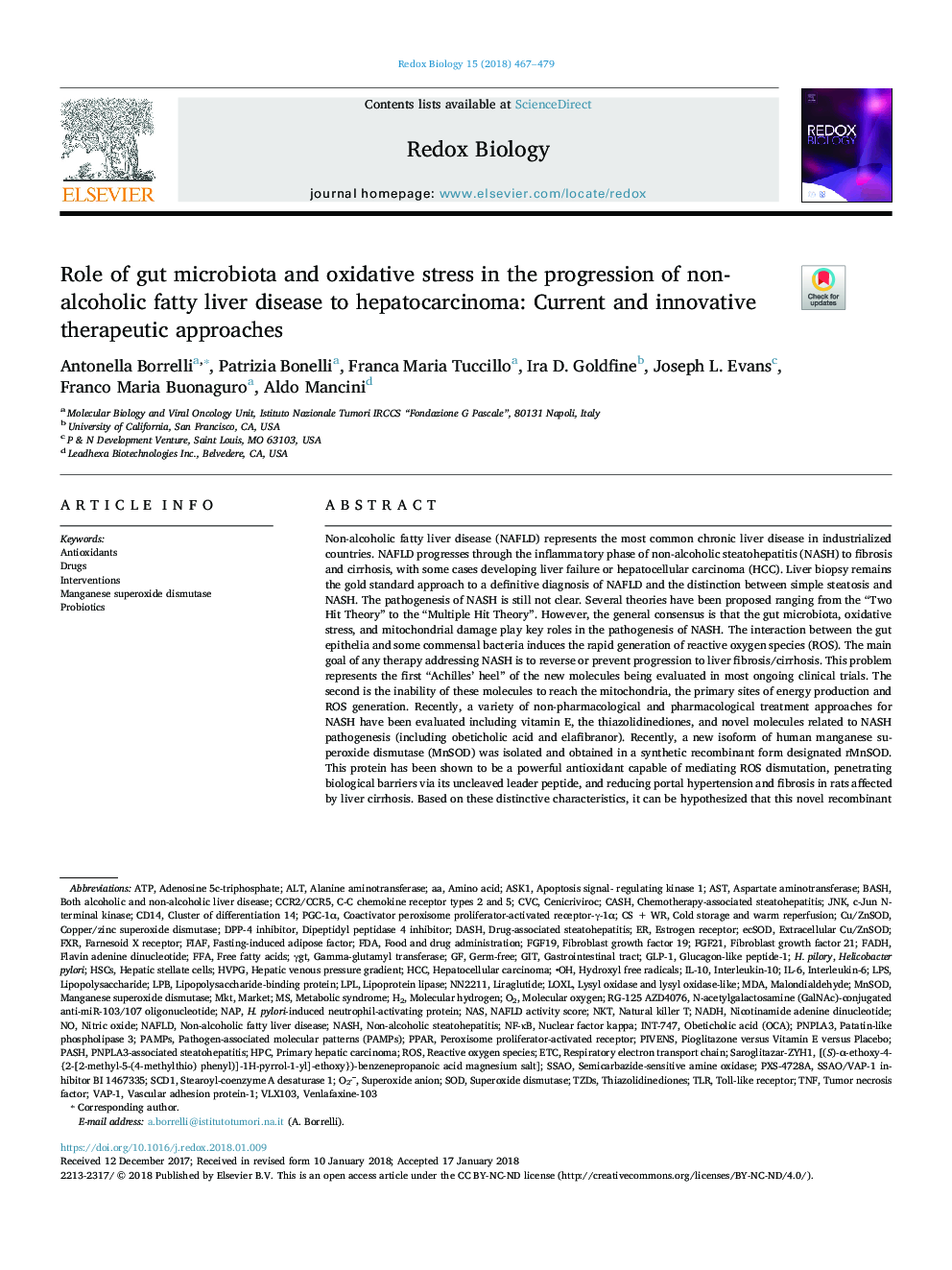| کد مقاله | کد نشریه | سال انتشار | مقاله انگلیسی | نسخه تمام متن |
|---|---|---|---|---|
| 8286519 | 1535835 | 2018 | 13 صفحه PDF | دانلود رایگان |
عنوان انگلیسی مقاله ISI
Role of gut microbiota and oxidative stress in the progression of non-alcoholic fatty liver disease to hepatocarcinoma: Current and innovative therapeutic approaches
ترجمه فارسی عنوان
نقش میکروبیولوژیک روده و استرس اکسیداتیو در پیشرفت بیماری کبد چرب غیر الکلی به هپاتوکارسینوم: روش های درمانی فعلی و ابتکاری
دانلود مقاله + سفارش ترجمه
دانلود مقاله ISI انگلیسی
رایگان برای ایرانیان
کلمات کلیدی
NF-κBLPSIL-6JnkNAPHPCflavin adenine dinucleotideFFAPAMPsGITALTPPARNASIL-10MnSODTLRGLP-1PGC-1αCVCCD14ASK1FXRLPLHVPGHSCsPNPLA3NKTFGF21γGTSCD1FGF19VAP-1LPBSSAOLOXLDipeptidyl peptidase 4 inhibitorPathogen-associated molecular patterns (PAMPs)FDAMDATNFNAFLDFIAFFADHfasting-induced adipose factorc-Jun N-terminal kinase - C-Jun N-terminal kinaseecSOD - ecsodfarnesoid X receptor - Farnesoid X گیرندهHCC - HCClipopolysaccharide-binding protein - lipopolysaccharide-binding پروتئینROS - ROSTZDs - TZD هاATP - آدنوزین تری فسفات یا ATPAST - آسپارتات ترانس آمینازAspartate aminotransferase - آسپارتات ترانس آمیناز یا AST Alanine aminotransferase - آلانین آمینوترانسفرازsemicarbazide-sensitive amine oxidase - آمین اکسیداز حساس به سمیکاربازیدamino acid - آمینو اسیدAntioxidants - آنتی اکسیدانsuperoxide anion - آنیون سوپر اکسیدNon-alcoholic steatohepatitis - استئاتوهپاتیت غیرالکلیStearoyl-coenzyme A desaturase 1 - استارویل کوآنزیم دساتوراز 1Free fatty acids - اسیدهای چرب آِزادMolecular oxygen - اکسیژن مولکولیInterleukin-10 - اینترلوکین 10interleukin-6 - اینترلوکین ۶Market - بازارgerm-free - بدون میکروبnon-alcoholic fatty liver disease - بیماری کبدی چربی غیر الکلیthiazolidinediones - تیازولیدیدونهاToll-like receptor - تیالآرDASH - خط تیرهcluster of differentiation 14 - خوشه تمایز 14Drugs - داروGastrointestinal tract - دستگاه گوارشHydroxyl free radicals - رادیکال های آزاد هیدروکسیلFood and Drug Administration - سازمان غذا و داروSOD - سدHepatic stellate cells - سلولهای ستارهای کبدیMetabolic syndrome - سندرم متابولیکmanganese superoxide dismutase - سوپر اکسید دیسموتاز منگنزSuperoxide dismutase - سوکسوکس دیسموتازHepatic venous pressure gradient - شیب فشار خون وریدیPASH - صورت سود و زیانfibroblast growth factor 19 - عامل رشد فیبروبلاست 19fibroblast growth factor 21 - فاکتور رشد فیبروبلاست 21tumor necrosis factor - فاکتور نکروز تومورnatural killer T - قاتل طبیعی TLiraglutide - لیراگلوتیدLipoprotein lipase - لیپو پروتئین لیپازlipopolysaccharide - لیپوپلی ساکاریدmalondialdehyde - مالون دی آلدهیدInterventions - مداخلاتCu/ZnSOD - مس / ZnSODcopper/zinc superoxide dismutase - مس / روی سوپراکسید دیسموتازDPP-4 inhibitor - مهارکننده DPP-4NADH - نادانNAFLD activity score - نمره فعالیت NAFLDNash - نوشNitric oxide - نیتریک اکسیدnicotinamide adenine dinucleotide - نیکوتین آمید adenine dinucleotideHelicobacter pylori - هلیکوباکتر پیلوریMolecular hydrogen - هیدروژن مولکولیETc - و غیرهProbiotics - پروبیوتیکVascular adhesion protein-1 - پروتئین چسبندگی عروقی-1CASH - پول نقدglucagon-like peptide-1 - پپتید 1-گلوکاگون-مانندHepatocellular carcinoma - کارسینوم هپاتوسلولار(کارسینوم سلولهای استخوانی)Gamma-glutamyl transferase - گاما گلوتامیل ترانسفرازReactive oxygen species - گونههای فعال اکسیژنEstrogen receptor - گیرنده استروژنperoxisome proliferator-activated receptor - گیرنده فعال فعال پروکسیوم•OH - • OH
موضوعات مرتبط
علوم زیستی و بیوفناوری
بیوشیمی، ژنتیک و زیست شناسی مولکولی
سالمندی
چکیده انگلیسی
Non-alcoholic fatty liver disease (NAFLD) represents the most common chronic liver disease in industrialized countries. NAFLD progresses through the inflammatory phase of non-alcoholic steatohepatitis (NASH) to fibrosis and cirrhosis, with some cases developing liver failure or hepatocellular carcinoma (HCC). Liver biopsy remains the gold standard approach to a definitive diagnosis of NAFLD and the distinction between simple steatosis and NASH. The pathogenesis of NASH is still not clear. Several theories have been proposed ranging from the “Two Hit Theory” to the “Multiple Hit Theory”. However, the general consensus is that the gut microbiota, oxidative stress, and mitochondrial damage play key roles in the pathogenesis of NASH. The interaction between the gut epithelia and some commensal bacteria induces the rapid generation of reactive oxygen species (ROS). The main goal of any therapy addressing NASH is to reverse or prevent progression to liver fibrosis/cirrhosis. This problem represents the first “Achilles' heel” of the new molecules being evaluated in most ongoing clinical trials. The second is the inability of these molecules to reach the mitochondria, the primary sites of energy production and ROS generation. Recently, a variety of non-pharmacological and pharmacological treatment approaches for NASH have been evaluated including vitamin E, the thiazolidinediones, and novel molecules related to NASH pathogenesis (including obeticholic acid and elafibranor). Recently, a new isoform of human manganese superoxide dismutase (MnSOD) was isolated and obtained in a synthetic recombinant form designated rMnSOD. This protein has been shown to be a powerful antioxidant capable of mediating ROS dismutation, penetrating biological barriers via its uncleaved leader peptide, and reducing portal hypertension and fibrosis in rats affected by liver cirrhosis. Based on these distinctive characteristics, it can be hypothesized that this novel recombinant protein (rMnSOD) potentially represents a new and highly efficient adjuvant therapy to counteract the progression from NASH to HCC.
ناشر
Database: Elsevier - ScienceDirect (ساینس دایرکت)
Journal: Redox Biology - Volume 15, May 2018, Pages 467-479
Journal: Redox Biology - Volume 15, May 2018, Pages 467-479
نویسندگان
Antonella Borrelli, Patrizia Bonelli, Franca Maria Tuccillo, Ira D. Goldfine, Joseph L. Evans, Franco Maria Buonaguro, Aldo Mancini,
